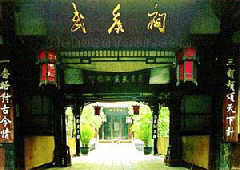The Ancestral Temple of Marquis Wu (Wu Hou Ci) is located in the southern suburb of Chengdu City in Sichuan Province.
 The Ancestral Temple of Marquis Wu was first built in the sixth century, next to the ancestral temple of Liu Bei, who was the king of Shu Han in the Three Kingdoms Period (220-280). This temple was merged into the Zhaolie Temple in the early years of the Ming Dynasty (1368-1644). Therefore the title on the plaque at the gate consists of four Chinese characters which mean it is the ancestral temple for the worship of both Liu Bei and Zhu Geliang.
The Ancestral Temple of Marquis Wu was first built in the sixth century, next to the ancestral temple of Liu Bei, who was the king of Shu Han in the Three Kingdoms Period (220-280). This temple was merged into the Zhaolie Temple in the early years of the Ming Dynasty (1368-1644). Therefore the title on the plaque at the gate consists of four Chinese characters which mean it is the ancestral temple for the worship of both Liu Bei and Zhu Geliang.
Zhu Geliang (181-234) was born in Yangdu County of Langxie Province (today's Yishui County of Shandong Province) in the last years of the Eastern Han Dynasty (25-220). He was a prominent statesman and strategist in the history of China. He reached his highest official rank as the prime minister of the regime of Shu Han and was conferred Marquis of Loyalty and Strategy after his death.
The existing structures of the Ancestral Temple of Marquis Wu were rebuilt in the eleventh year (1672) of the reign of Kangxi in the Qing Dynasty (1644-1911). It covers an area of fifty-six mu. Backing the north and facing the south, the ancestral temple was surrounded by a red wall with patina and elegance. The layout in the ancestral temple is compact with five courtyards. The main structures consist of the main entrance, the second entrance, the Hall of Liu Bei, the lobby and the Hall of Zhu Geliang. The halls and porches are connected harmoniously and artistically. The yard behind the main entrance is quiet and elegant, sheltered by luxuriantly green pines and cypresses. Among those old cypresses stand six steles. The largest one was engraved and set up in the fourth year (809) of the reign of Emperor Xianzong in the Tang Dynasty (618-907). The epigraph was drafted by famous prime minister Pei Du at that time, made out by the well-known calligraphist Liu Gongzhuo and engraved by Lu Jian. For the article, the calligraphy and the engraving were all of the first class, the stele was reputed as the Stele of Three Superb Works by the later generations.
Behind the second entrance is the Hall of Liu Bei, which is high, grand and gorgeous. In the center of the hall stands the gilt statue of Liu Bei. On the east wall of the hall is the woodcarving Long Zhong Du by Zhu Geliang, which was made out by the modern calligraphist Zhen Yinmo. And on the west wall is the woodcarving Chu Shi Biao, which is said to be made out by Yue Fei, a national hero in the Song Dynasty (960-1279). In the east and west wing halls of the Hall of Liu Bei stand the statues of Guan Yu, Zhang Fei and others. Along the east and west porches stand twenty-eight officials and officers of the Shu Han Kingdom.
The Hall of Zhu Geliang is next to the Hall of Liu Bei. The hall is grand and wide with the gilt sitting statues of the three generations of Zhu Geliang. There are over ten steles and couplets inside or outside the hall paying a tribute to the wisdom and feat of Zhu Geliang.
Exiting the Hall of Zhu Geliang and to the west passing a small bridge, one comes to the Tower of Laurel and Lotus, near which there is a lotus pond. The rippling water is glittering in the pond surrounded by thriving trees. Beside the tower is the Zither Pavilion. Passing the pavilion and walking through the moon gate named Zhong You Han Jia Yun, one comes to a really quiet and secluded place. Far into a bamboo forest, a zigzag passageway between red walls blocks people's sight. At the end of the passageway lies the tomb of Liu Bei.
There are over thirty steles and couplets in the Ancestral Temple of Marquis Wu. The concise words, profound meaning and exquisite calligraphy are always being appreciated.
